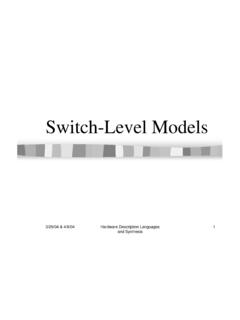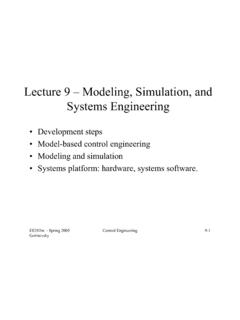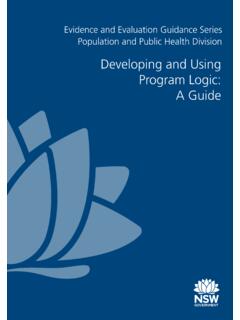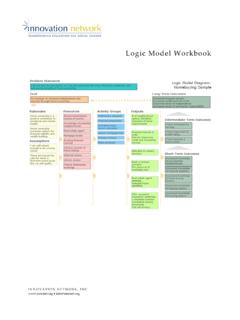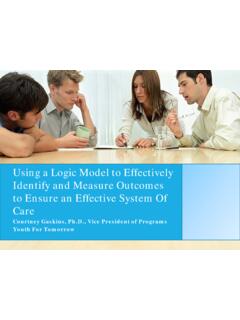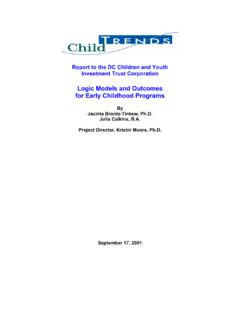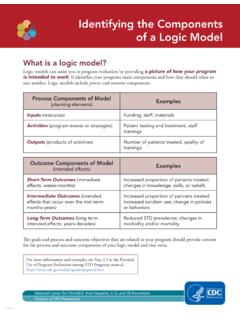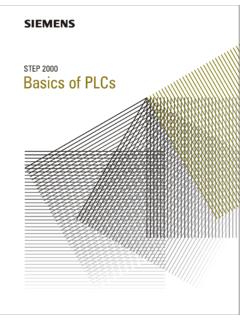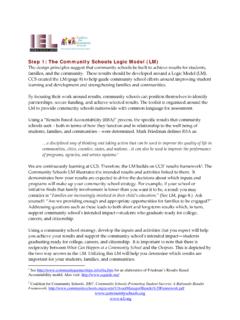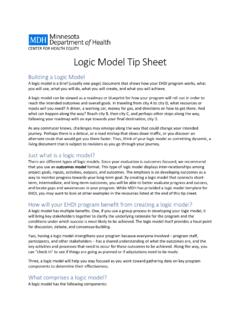Transcription of Logic Models: A Beginner’s Guide - Michigan
1 1 Logic Models: A beginner s Guide A Logic model is an organized and visual way to display your understanding of the relationships among the resources you have to operate your program, the activities you plan, and the changes or results you hope to achieve. Logic models are sometimes referred to as road maps for the organization. They help to illustrate how the program is going to work, and what the program will do to achieve the desired results Making a Logic model for your organization can be helpful in a number of ways. Some of the best reasons to invest the time needed to create a Logic model are that it: makes your assumptions explicit; allowing you to challenge and examine them helps to build shared understanding and expectations of your program among staff and other stake-holders helps you identify the data you need to collect so that you can monitor and improve programming tells stakeholders the problem the program focuses on and how the program is qualified to address it helps to identify what evaluation questions should be asked and why is often required by funders Basic format of a Logic model : InputsActivitiesOutputsOutcomes2 A Logic model contains four components: inputs, activities, outputs, and outcomes.
2 Inputs: What the organization invests in the program. (Examples: money, staff, volunteers, time, equipment, materials, technology, partners, etc.) Activities: What the program does. (Examples: tutor, teach financial literacy, serve meals, mentor, etc.) Outputs: The direct results of the program activities. How much/many activities provided (number of youth matched with a mentor, number of tutoring sessions, number of youth served, etc.) Outcomes: The benefits realized in the population served by the program. Answers the question So what difference does the program make? (new skills, change in behavior, change in attitudes, new knowledge, etc.) People often mistakenly describe the outputs of their organization as the outcome. For example, a youth club may state that the outcome of their organization is that they serve 50 youth a year, providing them a safe place to go after school.
3 Their statement is describing something that they did, not the change in the population served as a result, meaning that their statement is actually an output. An example of an outcome could be youth participating in the program are 50% less likely to use drugs than their peers. Output v. Outcome Don t mistake what your organization does with the change that results in those you serve. Funders want to know what difference your organization is making, not simply that you are doing something. Outputs are what you DO. Outcomes are the CHANGE in the population served. An easy way to remember this is that: C is for Change Outcomes = change. Here are some more examples to get you thinking about the difference between outputs and outcomes: Program Output (what it does) Outcome (the change as a result)
4 Free medical clinic Fifty low-income individuals are provided free doctor visits 50% decrease in emergency room visits by population served in the year following initial contact Math tutoring program Seventy youth receive math tutoring twice a week during the school year 100% of youth served improve their ISTEP scores in math from the start of the school year compared to the spring test Youth mentoring Thirty youth are matched with an adult mentor for the year 80% of youth served report increased self esteem following one year of mentoring Dropout prevention Forty youth at risk of dropping out receive weekly case management services 85% of youth in program for one year or longer graduate high school in four years 3 Outcomes A helpful Guide for developing outcomes for your program is the acronym SMART.
5 Outcomes for your program should be: Specific - target the population you serve and the issue you are concerned with Measurable - expressed in a way that can be measured Action-oriented something that the organization can act on and impact Realistic and relevant something that is within the realm of possibility for your organization, and related to the problem the program addresses Timed indicate when the outcome will be achieved Outcomes are often divided up into three categories: Initial, intermediate, and long-term. Initial: Change in knowledge, attitude, or skills Intermediate: Change in behavior or action resulting from new knowledge Long-term: Change in life condition and/or status Categories of Outcomes To make it easy to remember, you can think of it as ABC Attitude (initial), Behavior (intermediate), Condition (long-term).
6 Just remember that attitude also includes knowledge/skills. Looking again at the examples of outcomes, we can further break down the outcomes into these three categories. The outcomes given previously are in bold. Program Initial Outcome (attitude) Intermediate Outcome (behavior) Long-term Outcome (condition) Free medical clinic Recipients learn how to better manage their health and where to access community resources 50% decrease in emergency room visits by population served in the year following initial contact Those served have a higher quality of life and longer life expectancy Math tutoring program 100% of youth served improve their ISTEP scores in math from the start of the school year compared to the spring test 90% of youth served are able to move on to the next grade Youth graduate high school Youth mentoring 80% of youth served report increased self esteem following one year of mentoring Youth served for one year are 40% less likely to use drugs compared to their peers.
7 Youth avoid delinquent behaviors and become responsible citizens Dropout prevention 100% of youth served understand the economic impact of dropping out of school 90% of youth served will advance to the next grade 85% of youth in program for one year or longer will graduate high school in four years 4 Think about your organization, or one you are familiar with, and list the outputs and outcomes of two programs. Make sure they are SMART. Programs Output (What it does) Outcome (the change as a result) Now using the same programs, break down the outcomes into the following categories. Program Initial Outcome (A) Intermediate Outcome (B) Long-term Outcome(C) 5 If-Then The Logic model is a depiction of if-then relationships.
8 If we invest these inputs/resources, then the activities can take place; if the activities take place, then the outputs will result; if the outputs result, then the outcomes will be achieved. Now that we have a basic understanding of what a Logic model is, how it can be useful, and the difference between outputs and outcomes; let s start the process of building a Logic model for your organization. Developing a Logic model The foundation for a Logic model rests on the problem that the program is responding to. To effectively develop a Logic model , you must first be aware of what problem the program will be addressing. Take some time to examine the need for your program. Here are some questions to think about regarding the need your program seeks to address: - How can you document the need for your program (data)?
9 - How large is the problem (numbers)? - Who are you trying to impact with the program (specific populations)? - Is the program reasonable in light of the need? Some other things to consider as you prepare to draft your Logic model : - Who will use the Logic model / what purpose will it serve? - Who should be involved in helping to make it? - What have other organizations done to address the need your program is targeting? Next, we will look at writing out your Logic model step-by-step. Read through each of the steps, then use the Logic model table following the step-by-step outline to create one for your program. InputsActivitiesOutputsOutcomes Initial Intermediate Long-term6 Step 1: Identify the long-term outcomes of your program Long-term outcomes are the changes in life state experienced by the population served as a result of the program.
10 Examples: At-risk youth will graduate high school; pregnant teens will give birth to healthy babies - Be sure that the client is the focus of the goal, not your organization - Make the outcome active. The long-term outcome should be something the client will do/achieve, not what will be done/provided to them - Some good questions to ask yourself: What are we trying to achieve with our clients? What does success look like for our clients? If the program is a success, how will our clients lives be changed? Step 2: Identify the initial and intermediate outcomes of your program Initial outcomes (attidude) are what impact the program has on the attitudes, skills, and knowledge of the population served by your program. Examples: youth will understand the consequences of dropping out of school; pregnant teens increase knowledge of proper nutrition Intermediate outcomes (behavior) are the changes in behavior exhibited by the population the program serves as a result of their increase in knowledge.










